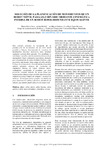Mostrar o rexistro simple do ítem
Solución de la planificación de movimientos de un robot móvil paralelo binario mediante cinemática inversa de un robot hiper-redundante equivalente
| dc.contributor.author | Pérez-Checa, Mario | |
| dc.contributor.author | Peidró, Adrián | |
| dc.contributor.author | Jiménez, Luis Miguel | |
| dc.contributor.author | Payá, Luis | |
| dc.contributor.author | Reinoso, Óscar | |
| dc.date.accessioned | 2022-09-02T10:10:17Z | |
| dc.date.available | 2022-09-02T10:10:17Z | |
| dc.date.issued | 2022 | |
| dc.identifier.citation | Pérez-Checa, M., Peidró, A., Jiménez, L. M., Payá, L., Reinoso, O. (2022) Solución de la planificación de movimientos de un robot móvil paralelo binario mediante cinemática inversa de un robot hiper-redundante equivalente. XLIII Jornadas de Automática: libro de actas, pp. 820-827. https://doi.org/10.17979/spudc.9788497498418.0820 | es_ES |
| dc.identifier.isbn | 978-84-9749-841-8 | |
| dc.identifier.uri | http://hdl.handle.net/2183/31341 | |
| dc.description.abstract | [Resumen] Este artículo presenta la resolución de la planificación de movimientos de un robot móvil paralelo y binario, determinando la secuencia de movimientos discretos necesarios para alcanzar cualquier posición final deseada. Este problema se reformula y resuelve como la cinemática inversa de un manipulador híper-redundante equivalente, formado por concatenación de tantos módulos binarios como posiciones intermedias debe ocupar el robot móvil a lo largo de su trayectoria. Esta reformulación permite aplicar eficientes técnicas de resolución de cinemática inversa de robots binarios hiperredundantes, resolviendo el problema con gran precisión, evitando métodos de fuerza bruta por enumeración exhaustiva que resultan imprácticos por requerir excesivos tiempos de cómputo y recursos de memoria. Se incluyen varios ejemplos en simulación para demostrar la validez y eficiencia del método de cálculo, que además puede aplicarse en tiempo real. | es_ES |
| dc.description.abstract | [Abstract] This paper presents the solution of motion planning of a parallel binary mobile robot, in order to find the sequence of movements necessary to reach any desired target. This problem is reformulated as the inverse kinematics of an equivalent hyper-redundant manipulator built by stacking as many binary modules as the number of intermediate positions that the mobile robot must traverse along its trajectory. This allows us to apply efficient techniques for the inverse kinematics of binary hyper-redundant robots, solving the problem accurately, avoiding brute-force methods that enumerate all configurations and require long computation times and large memory allocation. The simulations show the validity and efficiency of the method, which can be used in real time. | es_ES |
| dc.description.sponsorship | Este trabajo es parte del proyecto PID2020-116418RB-I00 financiado por MCIN/AEI/10.13039/501100011033 | es_ES |
| dc.language.iso | spa | es_ES |
| dc.publisher | Universidade da Coruña. Servizo de Publicacións | es_ES |
| dc.relation.uri | https://doi.org/10.17979/spudc.9788497498418.0820 | es_ES |
| dc.rights | Atribución-NoComercial-CompartirIgual 4.0 Internacional (CC BY-NC-SA 4.0) https://creativecommons.org/licenses/by-nc-sa/4.0/deed.es | es_ES |
| dc.rights.uri | http://creativecommons.org/licenses/by-nc-sa/3.0/es/ | * |
| dc.subject | Robot móvil | es_ES |
| dc.subject | Robot binario | es_ES |
| dc.subject | Robot paralelo | es_ES |
| dc.subject | Robot híper-redundante | es_ES |
| dc.subject | Cinemática inversa | es_ES |
| dc.subject | Mobile robot | es_ES |
| dc.subject | Binary robot | es_ES |
| dc.subject | Parallel robot | es_ES |
| dc.subject | Hyper-redundant robot | es_ES |
| dc.subject | Inverse kinematics | es_ES |
| dc.title | Solución de la planificación de movimientos de un robot móvil paralelo binario mediante cinemática inversa de un robot hiper-redundante equivalente | es_ES |
| dc.title.alternative | Solution of motion planning of a binary parallel mobile robot through inverse kinematics of an equivalent hyper-redundant robot | es_ES |
| dc.type | info:eu-repo/semantics/conferenceObject | es_ES |
| dc.rights.access | info:eu-repo/semantics/openAccess | es_ES |
| UDC.startPage | 820 | es_ES |
| UDC.endPage | 827 | es_ES |
| dc.identifier.doi | https://doi.org/10.17979/spudc.9788497498418.0820 | |
| UDC.conferenceTitle | XLIII Jornadas de Automática | es_ES |






